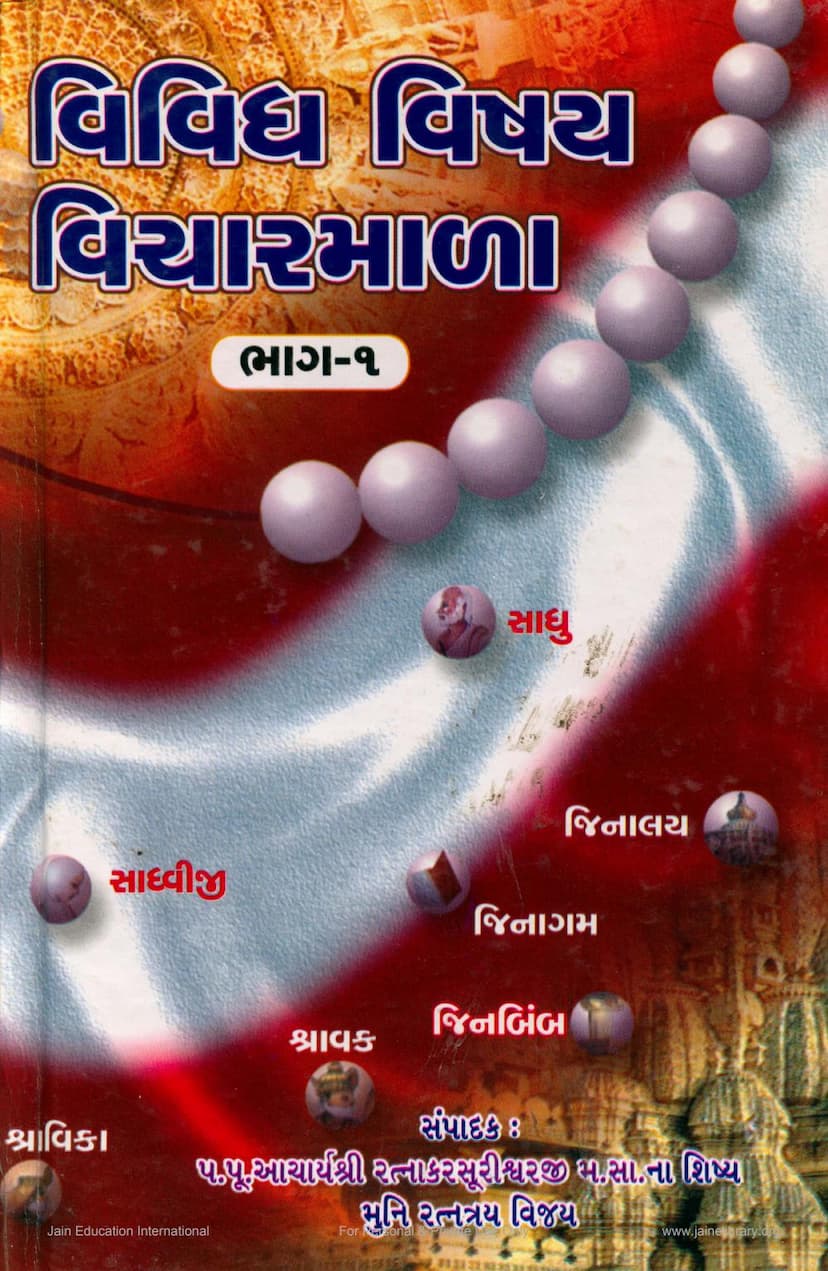Vividh Vishay Vicharmala Part 01
Added to library: September 2, 2025

Summary
The provided text is the first part of a Jain book titled "Vividh Vishay Vicharmala" (Various Topics Garland of Thoughts), compiled by Muni Ratnatray Vijayji, disciple of Acharya Shri Ratnakar Surishwarji. The book is published by Ranjanvijay Jain Pustakalay.
This summary focuses on the content and themes presented in the initial pages of the book, as these are the only parts available in the provided text.
Overview of the Book's Purpose and Content:
The introductory pages highlight the book's aim to disseminate Jain knowledge in a simple and accessible language. It acknowledges that the original Jain Agams and scriptures are profound but often difficult to access due to their complexity and language. Therefore, "Vividh Vishay Vicharmala" aims to simplify and present these concepts through extensive stories and examples, making them relatable and understandable for a wider audience. The preface mentions that the series, originally published in 8 parts, was out of print for 40 years and this is a re-edition.
Key Themes and Topics Covered (Based on available information):
The text provides a glimpse into the vastness of Jain philosophy and practice, covering a wide range of subjects across its various volumes. Based on the table of contents and introductions, the initial volumes focus on:
- Volume 1: The nature of Deities (Deva), Spiritual Guides (Guru), and Religion (Dharma). It includes discussions on deity worship, types of worship, definitions of a true Guru versus a false one, and a detailed explanation of Dharma with over 125 illustrative stories.
- Volume 2: The role and duties of lay followers (Shravak), and practices like Samayik (meditation), Pratikraman (atonement rituals), and Paushadh (fasting). It emphasizes the rarity of human birth and the importance of righteous conduct through examples.
- Volume 3: A comprehensive collection of 64 topics, serving as a reference for Jainism, covering most subjects in detail.
- Volume 4: The nature and distinctions of Right Faith (Samyaktva) and False Faith (Mithyatva), described with examples. It also discusses negative traits, vices, and misconduct, along with methods for their renunciation, and conversely, the characteristics of virtues, good conduct, and the true Dharma.
- Volume 5: The significance of the 24 Tirthankaras and contemplation on the 24 stages (Dandaks). It explores the Kleshas (mental afflictions) and offers insights into ethical and moral conduct for a happy and prosperous life, supported by illustrative stories.
- Volume 6: Various subjects including the nature of a person, time, charity, guests, deception, vows, 32 virtues, intelligence, foolishness, edible vs. non-edible substances, and atonement (Prayashchit), all explained with examples.
- Volume 7: The path to self-upliftment and the acceptance of pure Dharma, covering the nature of the soul and its states (Bhavas). It discusses approximately 1000 diverse topics.
- Volume 8: The importance of Dharma for a successful human life and achieving liberation (Nishreyas) and prosperity (Abhyudaya). It offers guidance on 320 different beneficial thoughts and attitudes.
Specific Content Highlighted in the Provided Pages:
The initial pages delve into specific aspects of Jain practice and belief, including:
- The Merit of Building Jain Temples: The text quotes verses emphasizing the immense spiritual merit gained by constructing temples with precious materials and contributing to their upkeep. It also states that the merit of renovating old temples is eight times greater than building new ones.
- The Eighteen Imperfections (Dosha): A list of eighteen defects from which the Tirthankaras are free is provided. This is a fundamental concept in Jainism, highlighting the purified state of enlightened beings.
- The Virtues of Tirthankaras: The text describes the perfect knowledge, detachment, power, and dharma associated with Tirthankaras, along with their 32 auspicious signs (Atishayas) and 35 divine attributes of their speech.
- Samavsaran: A detailed description of the divine assembly place (Samavsaran) created by the gods for the Tirthankaras' sermons, including its architecture, layout, and adornments.
- The Power of Jain Vachanamrut (Divine Speech): The text lists the qualities of the Tirthankaras' speech, describing it as a sword that cuts the veil of ignorance, a boat to cross the ocean of existence, and the sun that dispels the darkness of delusion.
- The Fruit of Jin Vandana (Salutation to Jinendra): The text elaborates on the profound spiritual benefits of saluting the Jinendra, detailing how even the intention to salute brings merit, and the act of going to the temple, circumambulating it, and offering salutations yields progressively greater spiritual rewards, equivalent to years of fasting.
- The Importance of Proper Rituals: The text emphasizes the need for performing rituals with correct procedures (Vidhi) to achieve desired results, citing the example of a story where improper performance leads to negative consequences.
- The Story of Surendradatta: This story illustrates the efficacy of performing the five-part salutation (Panchanga Pranam) with devotion, showing how it can lead to great fortune and spiritual progress.
- The Story of Shree Datta: This narrative emphasizes the importance of correct rituals and faith in the process of devotion.
- The Story of Vasudev: This story likely highlights the significance of circumambulation and righteous actions.
Overall Impression:
"Vividh Vishay Vicharmala Part 01" appears to be a comprehensive and practical guide to understanding and practicing Jainism. It uses stories and detailed explanations to make complex philosophical concepts accessible, encouraging devotees to live a life of virtue and devotion. The book strongly advocates for correct ritualistic practices and the purification of body, mind, and actions in service of the divine.